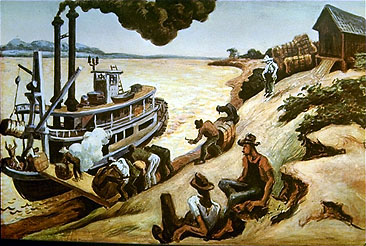Thomas Hart Benton, Cotton Loading (1928).
Thomas Benton, Cotton Loading, 1928, private collection
See Archie Green, Torching the Fink Books and Other Essays on Vernacular Culture (2001), p. 122.
‘Benton’s best work scenes touch rural life or extractive industries
(where mine or mill remain part Of an outdoor landscape). Generally,
he made no hard distinction between farm and factory. In numerous
vignettes about cotton, he documented transitions from the soil to
vessel’s hold. Benton captured planting, chopping, picking, ginning,
weighing, and river loading.
In the painting “Cotton Loading” (1928), black laborers manhandle
cotton bales while two idlers rest on the bank above the river boat. A
white man—plantation owner or gin boss—watches all. The river is
wide; the work, endless. Cotton farming is now heavily mechanized
and ginning, automated. Hence, Benton’s painting reminds viewers
either of a forgotten work practice, or Of a net which captured black and
white, cropper and planter, roustabout and pilot. “Cotton Loading”
does not alter by use of the word “folk.” Rather, we enlarge vocabular-
ies when we open ourselves to this scene’s full significance.’

